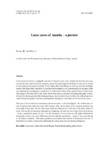Loess caves of Austria - a preview

Ver/
Use este enlace para citar
http://hdl.handle.net/2183/12588Coleccións
Metadatos
Mostrar o rexistro completo do ítemTítulo
Loess caves of Austria - a previewData
2013Cita bibliográfica
Cadernos do laboratorio xeolóxico de Laxe, 2013, 37: 65-72. ISSN: 0213-4497
Resumo
[Abstract] Loess caves account for a negligible amount of Austria’s caves only - despite the fact that the areas covered by loess and loess-loam comprise several thousand square kilometres. Loess can be found in the northern and eastern foreland of the Alpine Mountain Range as well as in the Styrian Basin south of the Alps. Only a handful of caves have been mapped so far, concentrated at a few spots. This eye-catching fact documents a certain lack of exploration rather than a general lack of loess caves. According to Striebel (2005) and others most loess caves are formed by piping and gully erosion, initiated by inhomogeneities like disintegrating roots and animal burrows where the infiltrating water causes fast-growing pipe structures, subsequently enlarging to caves that can be entered by cavers. The rate of cave evolution is tremendous. In several cases - so far investigated - the earliest onset of cave formation lies within the early 20th Century. This can be dated as the required gradient was man-made at that time. On the other hand distinctive alterations of the caves took place within 30 years. This can be documented strikingly by comparing old and new cave maps. The crucial points – from a quantitative point of view - for the formation of loess caves are still under fundamental discussion as there are severe differences in local climatic parameters – some of the areas belong to the driest in Austria – lithologies, gradients and human interventions. Furthermore, the role of dissolution of calcitic components enhancing the subsequent erosion remains ambiguous.
Palabras chave
Loess caves
Alpine mountain range
Styrian basin
Piping
Gully erosion
Alpine mountain range
Styrian basin
Piping
Gully erosion
ISSN
0213-4497





